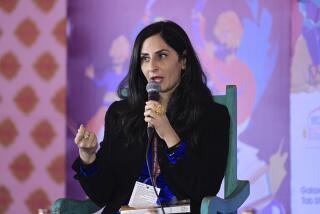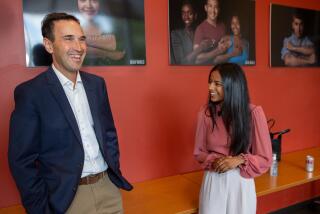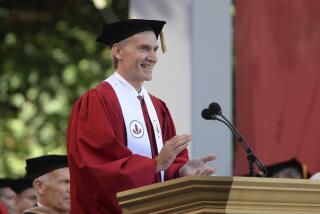Pepperdine’s Davenport: Of Law and the Gospel
- Share via
Seven years ago, David Davenport was working for one of San Diego’s most prestigious law firms in a 20th-story office with a picture window overlooking San Diego Bay, Coronado Island and the Pacific Ocean.
He was 28, a year out of law school, had been heavily courted by several major firms and had chosen this one, with carpeted stairways and occupying the three top floors of a bank building.
Became a Minister
Then he quit to become a minister for the Churches of Christ.
Some said he was making a mistake, that he was sloughing off a chance for great success and an elegant life style. But Davenport is satisfied that he made the right move.
On Tuesday evening, at 34, he will become one of the youngest college presidents in the nation when he takes over as the sixth head of Pepperdine University and its 6,500 students. Before 4,000 people at a Bible lecture in the university field house, he will formally commit to Pepperdine’s traditions.
“I am hoping,” he said recently, “that we can combine our traditions of Christian commitment and academic excellence and make Pepperdine a national leader in private education.”
Davenport, his wife, Sally, and their two children will soon move into the president’s home on the 830-acre Malibu campus.
The two-level, six-bedroom house with a pool and a Jacuzzi rests on a cliff overlooking Pacific Coast Highway, the Pacific Ocean and, on a clear day, Catalina Island.
The residence, donated by prominent California Republican Margaret Brock in 1972, sits next to a steep, brush-covered canyon and beside a mountain of large, terra-cotta boulders.
Beneath Reception Area
The family will live downstairs beneath a rich, wooded reception area and offices for Davenport and his staff.
A spiral staircase leads from a large, carpeted master bedroom with a fireplace to the president’s office above, and a large, tile-floored living room with another fireplace opens to a wide, grassy backyard that ends at a cliff.
The spacious home is a frequent attraction for tourists who wander the yard and peer in the windows. Outgoing President Howard A. White, who will become a fund-raiser and policy maker as president emeritus, once found a stranger in his bathroom. (White retreated and the stranger left.)
Davenport hopes to protect his family’s privacy and the safety of his daughter, Katie, 2, and his son Charlie, 8 months, by fencing in the yard and covering the pool and Jacuzzi.
The family will also convert one of the six bedrooms into a full kitchen so Sally Davenport can cook without going upstairs to the kitchen used for official functions.
The home is much more elaborate than the comfortable, three-bedroom, ocean-view condominium where the Davenports have been living.
Sally Davenport, who met her husband when both were students at the University of Kansas and who interrupted a graphic designing career to become a mother, said she will try to see that her children’s home life remains as peaceful as possible. She will also supervise the entertainment that a university president must provide.
Davenport says he will be comfortable in the spotlight at university functions. Still, the new chief executive, who used to fry doughnuts in the family bakery in Shawnee Mission, Kan., enjoys some less ostentatious pleasures too.
He likes to ride a boogie board, which is a small surfboard, and he turned down the university’s offer of a luxury car to keep his 1983 Buick LeSabre.
“I’m just not a Mercedes-Benz person at this point,” he said one evening outside his old vice president’s office on campus. “My car does the job and I’m not embarrassed to drive it to the Century Plaza. A car has never meant a great deal to me.”
Similar thinking enabled him to leave his law firm seven years ago. Davenport said he knew that he liked public speaking and working with people, but his practice was increasingly headed for the solitary work of trial preparation. He said he also knew that he found wealth and fine homes less important than job satisfaction.
He had preached in high school in Shawnee Mission and worked as a youth minister two years after college in the Churches of Christ, which do not require ordination for a clergyman. When a San Diego congregation offered a yearlong job as a minister, he took it.
Friends gave his name to administrators at Pepperdine, a Churches of Christ-affiliated school, and the following year the university law school offered a teaching position, which he accepted.
He was named the university’s general counsel in 1981 and executive vice president in 1983. A Board of Regents committee announced his appointment as president last June.
Davenport is the second youngest president in the university’s 48-year history. Hugh Tiner was 30 when he assumed the reins in 1939. Another school head, William S. Banowsky, was also 34 when he took over in 1971.
The new president, who says that tradition of young leadership may have smoothed his rise, will work in the president’s house in a dark, book-lined office where light filters through louvered shutters. He will continue the pattern he established as executive vice president, working from 8 a.m. until 6 p.m.
Wearing a gray pinstripe suit with a blue buttoned-down shirt and a tie, he sat on a swivel chair behind a teak desk and started one recent morning by meeting a student to discuss a case in a law class he still teaches and hopes to continue.
Later, sipping coffee from a paper cup, he met with his vice president for academic affairs. When William B. Phillips proposed an evaluation of undergraduate curriculum, Davenport leaned forward and banged his hand on the desk, enthusiastic about an important project that came out of a regularly scheduled meeting without his initiation.
“This is exciting,” he said. “This is exciting.”
Davenport leaned back, rested his feet against a post under the desk, and the men reached agreement on a number of issues.
At 10 a.m. he walked through the center of the campus with white stucco walls and red tile roofs gleaming in the sun to hear a speaker at a voluntary chapel service.
After the speech Davenport returned to his office to meet another vice president. Then he walked to a luncheon--which he began with a prayer--for university administrators.
Religion has been important at Pepperdine since auto supply millionaire George Pepperdine founded the small liberal arts school in 1937 with hopes that it would maintain close ties to the fundamentalist Churches of Christ.
Several school presidents, however, have had to deal with the delicate balance between open academics and close ties to the fundamentalist denomination. Today, the school requires 2,400 students in the liberal arts program to take two religion courses and to attend at least some religious convocations.
Davenport has grappled with a similar balance since high school when his inclination was to attend a Christian college of limited academic curriculum, but his father, now deceased, persuaded him to go to Stanford University.
“He felt that if I went to a place of great freedom and chose to be a Christian I would not only get a better education but grow as a Christian,” Davenport said.
Earning a bachelor’s degree at Stanford and a law degree from the University of Kansas, Davenport decided that his father was right.
Sometimes, he said, visitors considering Pepperdine as a school for their children insist that it should be either a strong Christian university or an excellent private college.
“And my answer always has been, and will continue to be, ‘No. We aren’t going to go either of those directions,’ ” Davenport said. “ ‘We will combine them and be Pepperdine.’ ”
More to Read
Sign up for Essential California
The most important California stories and recommendations in your inbox every morning.
You may occasionally receive promotional content from the Los Angeles Times.













